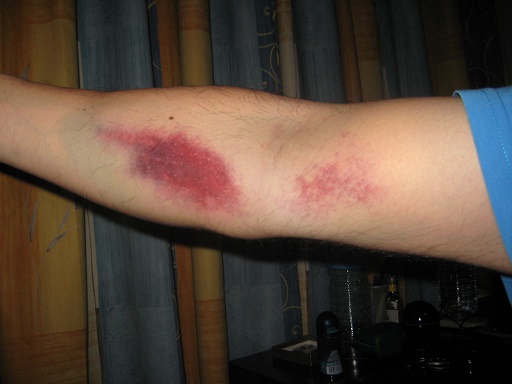For a nurse to administer a blood test, she has to attach a needle to a syringe and insert it into the blood vessel usually located in your wrist or elbow. As the needle pierces the skin, the person who receives the blood test will feel a prick. Once enough blood has been collected, the nurse will remove the needle and place a cotton pad on the injection site. Sometimes, you develop bruising after a blood test. Why?
What Causes Bruising After Blood Test?

- Bruising develops as a result of bleeding that occurs underneath the skin after the needle has been taken out.
- Bruising can also develop after the rupture of the pierced vein, in which case, a small hole opens up and blood starts leaking through it.
- And lastly, bruising may also develop as a result of the damage to a fragile blood vessel.
- If you do not apply enough pressure to the insertion point, bruising can also occur.
There are certain conditions that increase the risk of bruising, such as:
- Consumption of anticoagulants, such as aspirin
- Various bleeding disorders
- Swelling of the arm which makes it difficult to find the vein
- Older people who tend to develop bruises quite easily
If you would like to decrease your chances of bruising, inform the person who administrates the blood test about any above-mentioned conditions, and any other problems that you might have experienced during previous blood tests.
Even though it can look quite terrifying, bruising after blood test is rarely dangerous and will fade away after a week or two.
Note: However, if you are very prone to developing bruises even after a minor trauma to the skin, you should be concerned, as this could indicate improper function of your platelets, which is very dangerous. Talk to your doctor if this is happening to you, so he/she can run some tests and refer you to a specialist who can help determine the cause of your bruising.
How to Deal with Bruising After Blood Test
Follow the RICE system:
- Rest: Let your bruise heal properly, which means that you should avoid carrying anything heavy for the next 36 hours, after which you can continue your normal daily activities.
- Ice: Apply ice on the affected area. Never put it directly on your skin as it can damage your tissues, but rather wrap it in a towel.
- Compression: Put some pressure on the injection site.
- Elevation: You should try keeping your arm above your heart whenever you can.
Also, if necessary, take a pain reliever such as paracetamol; however, ibuprofen and aspirin should be abvoided in 24 hours after the test.
If your arm is swollen after 36 hours, try ''contrast bathing'' that consists of a cold cloth being put on the injection site for 10 minutes, after which a warm one for another 10 minutes. Repeat this a couple of times, and make sure that you end the treatment with a cold cloth.
Contact your medical professional if you:
- Notice that the pain is getting worse
- Feel a numbing sensation in your arms, hands or fingers
- Notice that your swelling is increasing
- Notice that your arm is red
- Notice that your arm is cold and pale
How to Prevent Bruising After Blood Test
You can successfully prevent bruising by applying solid pressure on the injection site 3 to 5 minutes after the needle has been removed. If your artery has been pierced, the pressure needs to be applied for a little longer.
Other Possible Complications of a Blood Test
As only a tiny bit of blood will be taken from your body during a blood test, there shouldn't be any big side-effects. Some people may feel a bit dizzy and even faint. If you are one of these people, remember to inform the nurse about it so that she can help you relax a little.